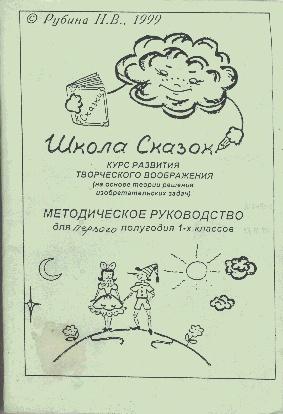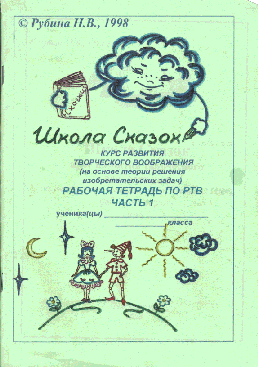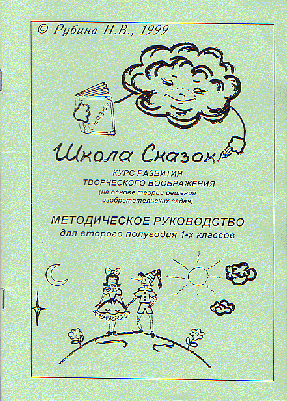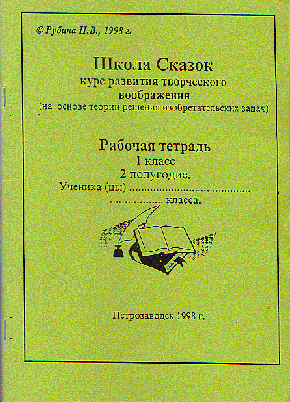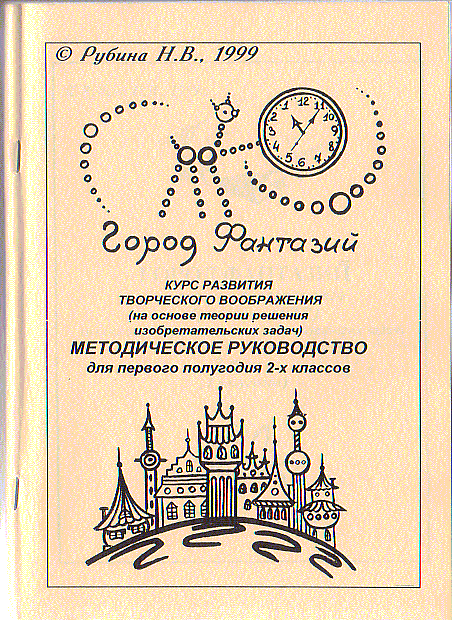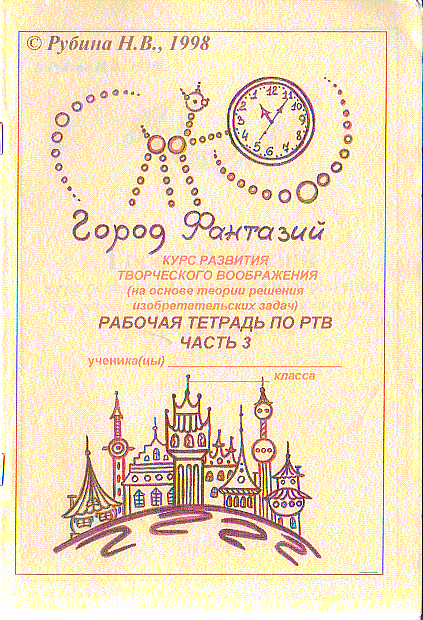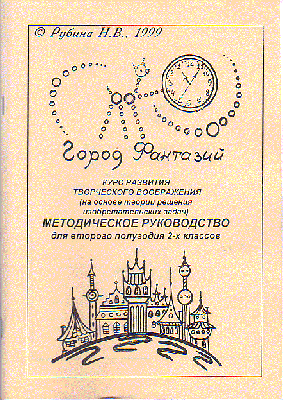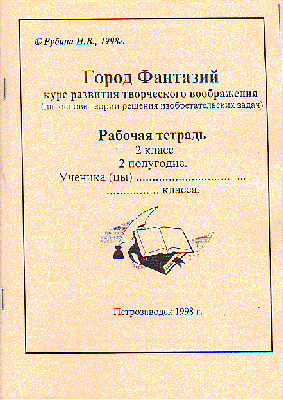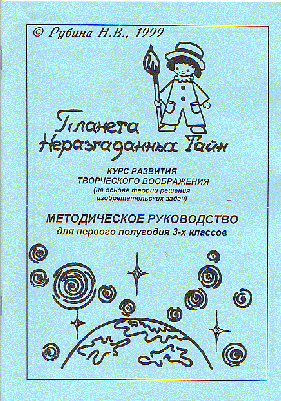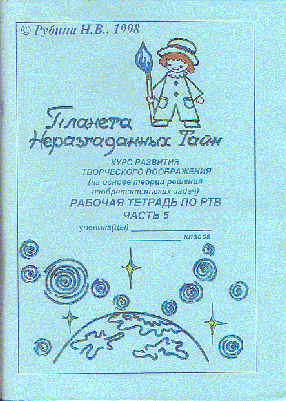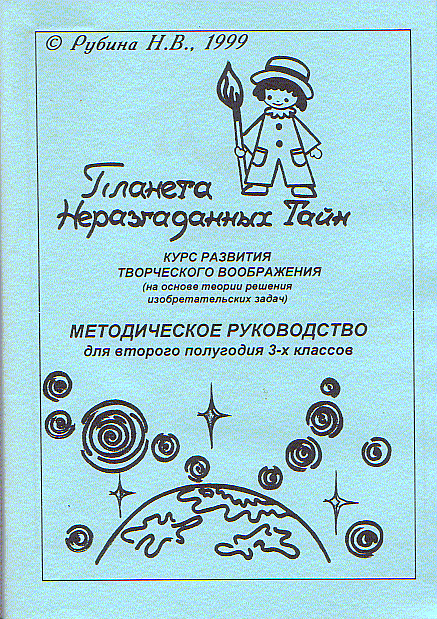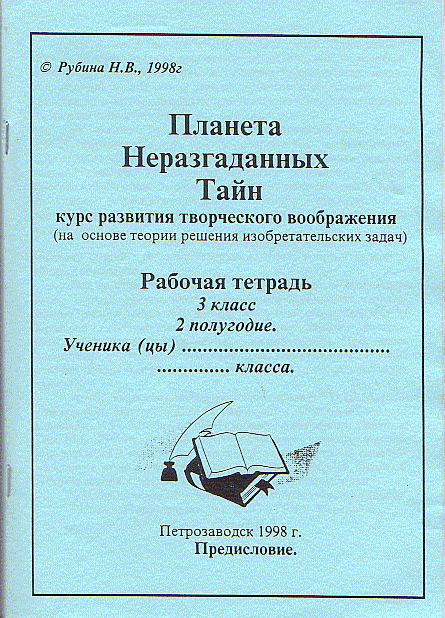It
is my great pleasure to start posting this course material for guiding
children to be creative. This posting is a fruit of my
visit to Russia and Belarus in August 1999. As I wrote in my
trip report on this Web site, I met many TRIZ specialists who are working
for education
of children of various ages and their teachers. At first it was
almost imbelievable for me that they are teaching the concepts of TRIZ
to children of elementary schools and even kindergartens. What in
TRIZ are they going to teach to children? How can it be possible?
Do children understand the essence of TRIZ, which even well-educated engineers
often feel difficult and puzzling? Responding to my questions,
Mrs. Natalia Rubina in Petrozavodsk gave me a copy of the full set of her
course material.
The course
is called "Creative Imagination Development (CID)". The course has
been developed in ex-USSR for these almost 40 years by Genrich Altshuller
at first and then a large number of his students, associates and followers.
The course name is sometimes written as "RTV" in Russian abbriviation written
in English alphabets or "Improvement of Creative Imagination" (ICI)
as in Salamatov's TRIZ Textbook. The necessity of creative imagination,
such as the ability to write a new scientific fiction (SF), was recognized
by Altshuller in the early stage of his teaching TRIZ to engineers.
Altshuller was also trying to teach young people the creative thinking
ways; for instance, around 1961, he wrote a series of inventive puzzles
every Sunday on a newspaper for children. Thus the CID course always
have two faces, one for children and the other for adults.
Mrs. Rubina
has taught this course for these seven years to children of 1st to
3rd Grades at Petrozavodsk School. #17 (Note: In Russia, children
of 1st through 11th Year are taught at the same school.) The course
materials translated here were prepared in 1998-1999 for her classes.
They form a full set of Workbooks for children and Methodological Guidebooks
for teachers for the six semesters of 1st to 3rd Grades. Such
a set is most valuable for us to understand what and how they are actually
teaching.
Translation
into English is done excellently by Dr. Irina Dolina, to my sincere
thanks. She graduated Moscow University of Foreign Languages and
did reseach at Institute of Oriental Studies, USSR Academy of Sciences.
Since 1993 she has been living in Japan with her husband. She was
my teacher of Russian language for two and half years before her moving
to downtown Tokyo. English translation of this material is often
difficult because of a plenty of riddles and word plays in Russian and
imaginary stories.
Technical editing
for these Web pages is done by Nakagawa, with trying to keep the layout
of the books as much as possible. With the aids of hyperlinks, readers
may easily refer to various relevant sections of the material.
Translating
and posting in English (i.e., not in Russian or in Japanese) aims to present
this work as widely and quickly as possible. We are going to post
this series chapter by chapter in the coming two or three years.
Together with the readers of this site, I wish to learn the full contents
of the CID course, which have not been published in English so far.
It must be
the author's and our pleasure that readers of this work find the course
instructive for new insights into children education and also into understanding
of TRIZ itself. With obtaining deeper understanding of the
essence of TRIZ, education of children in various ages will become more
creative and fruitful. I am very grateful to the Author, Mrs. Natalia
Rubina, for her permitting this public posting without any commercial reward
in our not-for-profit Web site, "TRIZ Home Page in Japan". Her Message
cited at the end of this page was delivered to me via e-mail as her Christmas
gift to all the possible readers, teachers and children in the world.
Feedbacks from
the readers are heartily welcome to the Author and to the Editor.
We wish to publish this course material in future in a book series in English
and in Japanese, if possible. So, please observe the copyrights of
this English version. If you are interested in using this material
in your classes or in publishing or circulating widely, please communicate
with the Author and the Editor via e-mail at the following addresses:
Author: Natalia V. Rubina:
"Natalia Rubina" <rubin@onego.ru>
(email address is changed. Feb. 19, 2002)
Editor: Toru Nakagawa: "Toru
Nakagawa" <nakagawa@utc.osaka-gu.ac.jp>
We live in a
changing world. Bare knowledge like a frozen copy of the past, can
not fully help us to solve the arising problems. An ability to solve
creative problems, an advanced imagination are the qualities that mostly
define a personality not only of tomorrow but of today, as well.
On the basis of Theory
of Inventive Problem Solving (TRIZ) the author of this book has worked
out and tested "The Program of the Course of Creative Imagination Development
for the elementary school". The controlled imagination allows a person
faster and simpler to adapt himself to changing conditions, therefore the
course CID is actively used by psychologists for diagnostics and psychological
correction of elementary school students.
In order to simplify the
work in the framework of this program a student book and a workbook were
prepared to be presented here.
The whole program is meant
for three grades: "Fairy tales school" - first grade; "The Fantasy
City" - second grade; "The Planet of Unsolved Mysteries" -
third grade. This program was used to instruct the kids of the first
to third grades of School #17 in the course of 4 years. The
classes were conducted once a week, the classes were divided into two groups.
The author expresses her
deep gratitude to the TRIZ creator G. S. Altshuller, and also to I. N.
Murashkovska, A. N. Nesterenko, M. C. Gafitulin, to Sergey and Svetlana
Sychovs, N. N. Khomenko, V. I. Timohov, Anatoly and Svetlana Gin,
M. S. Rubin, whose work helped a lot in creating the CID course and the
workbooks. And of course the help of the first-third grade students
of School #17 of Petrozavodsk was very valuable. Thank you, my dear
little magicians!
Send your remarks and
proposals at the following address:
185014, Petrozavodsk,
mail box 8, OO "TRIZ- Karelia", to N. V. Rubina.
Sometimes miracles happen in our life.
The opportunity to have met with you [Toru] was a real miracle for me.
It is an amazing feeling to realize that lots of people whom I even don’t
know will learn about my ideas, my dreams, my work [in this Web site].
It’s a pity that it’s impossible to transfer the sparks of the children’s
smiles, the depth of their pensive eyes and the joy of an adult, who has
come back to his childhood for a short period time.
During my childhood there
were many miracles and wonders. Every day I invented them for myself.
Carlson and Winnie the Pooh, a troubadour and the frightful forest brigands
were my friends. All of them were as real to me as my nanny, who
would read the fairy tales to me. Then I began to compose my own
fairy tales, including in them the episodes of my own life. I could
tell them for hours and my parents would listen to me patiently.
Meanwhile life was preparing
lots of revelations for me. Once a small, fluffy and very funny creature
– a collie puppy appeared in my home. The dog has become a devoted
friend and an attentive listener. And it was my favorite dog, as
a matter of fact, that has stirred up my interest in the animate nature
on Earth. That was very interesting and fine. But a dreamer
is no profession! Where and how to realize one’s dreams and fancies?
My encounter with TRIZ was an “accidental
natural result”. At TRIZ classes an absolutely different world has
opened to me. The world of a controlled imagination, where I was
fascinated by the greatness of ideas, the beauty and the elegance of solving
the problems. I came to know a wonderful world of TRIZ while I was
a fourth year student of a biological faculty of Petrozavodsk University.
Like all the students I was thinking about my future, my work, about my
life, its aims and its meaning, I was looking for the way to make
it really interesting.
At first my TRIZ classes
have become another ( maybe the most important) subject in my not so tense
university schedule. It was very exciting and we were fascinated
by the fantastic ideas, that were born just in our presence and sometimes
even in our own heads. There were seminars, meetings with TRIZ colleagues
and books, books…
Later at the beginning
of the fifth year we had trial classes at school. Of course
I wanted to tell the children about TRIZ. And of course, my first
lesson, I believed, had to include all the information I had accumulated.
No wonder, the kids didn’t remember much from my confused performance.
Nevertheless a few pupils from the class where I was teaching, soon joined
the creativity club “Heretic”, which was organized by us and my TRIZ teacher
at School No. 17 in Petrozavodsk. The club activities have
become for me a true school of elaborating, preparing and conducting
the TRIZ classes, of searching new forms of teaching, and building
up the friendly atmosphere of creativity.
Unfortunately I was not
closely acquainted with the TRIZ founder, H.S. Altshuller. I belong
to the generation of “his disciples’ disciples”. But even few meetings
with the great Master penetrate so deep in one’s soul that often
define one’s worldview, way of action, choices in life. I cherish
in my memory the amazingly clear, attentive, wise eyes, the eyes of the
man, who has looked far into the future. “Time is filtering through the
net of hours people, events and facts. A man can not see into
the future, but with every moment of his life he creates the patterns
of its mysterious look.”
And another episode lingers
in my memory. At the TRIZ conference ( July, 1997) we were
waiting for H.S.Altshuller’s appearance. It was difficult for him
to speak but the first words he said completely changed the atmosphere
of the conference, defined its direction and contents. He said:
“On June 1997 the great inventor Jacques Yves Cousteau died. Let’s
review his wonderful inventions and amazing life”. A year later Altshuller
himself deceased. Many things are changing, many things are seen
in an absolutely different way. And his ideas are being
realized; maybe, we see exactly the same things that his wise insight had
discovered long before.
I was very lucky.
In my life there is a person who teaches me every day, who teaches me to
be wiser, kinder, more inventive. We are always interesting
for each other. And I know: we are together and it means that all
will be fine. My husband has taught me everything I know about
TRIZ and creativity. Actually, during the years of work with the
children and teachers I have obtained my own interesting experience, and
my husband is telling me more and more often: “You know it much better
than me”. And I won’t hide from you that I am pleased to share my
experience with him, and sometimes even to boast my small and big achievements.
There is one more
wonder, created by H.S.Altshuller. It is the TRIZ movement, to be
more precise, the TRIZ “brotherhood”. This is a marvelous community
of people, whose main core of life is creativity. The communication
with them is often interesting, filled with a deep meaning and helps to
move forward. This world too was introduced to me by Michael.
I am grateful to him and to all those people who have accepted me in their
world, taught everything they knew and would always surprise me by their
ideas.
It happened
so that all my life was connected to school this way or another: my
mother is a teacher, and since my early childhood I have been watching
all the aspects of this hard, unpredictable and very interesting profession.
However, a proposal to conduct CID classes (Creative Imagination
Development) in the second grade was quite unexpected, as the second graders
are still very small kids - how to work with them? I was preparing
for my first lesson in the second grade for a whole month. The questions
have been piling up.
And finally the lesson
started. During the first 20 minutes I told everything that I had
planned for a whole lesson. In front of me there were 30 second graders,
who were waiting for the continuation of my lesson. Behind them,
in the last row there were a second grade teacher, a psychologist and –
“a support group”- Michael Rubin. I felt like leaving the class right
away. ”They should be taught by those who know how to do it,
I can’t …”. But my activities in the club “Heretic” have not been
wasted, plus the self-confidence which every TRIZ member has: there are
no unsolved problems. There is a “Yes-Now” game for the children.
Its rules are very simple: the players, while solving the riddle, can ask
the questions and the performer can only answer “yes” or “ no”. In
the course of our TRIZ classes we were solving lots of problems like that.
So, I have found the way out of this situation: the rest of the time the
kids spent joyfully looking for the answers and asking the questions.
And it was then that I realized that it was my life mission to teach
the children to create, to think and again to create. Very soon we
have come to a conclusion that everything that we needed for the classes
had to be made by ourselves. I don’t mean the materials we distributed
for the lessons, or the test cards. “What? How? When?”
There were lots of questions and very few answers.
The work on making
a file of materials has been going on for seven years already. Since
then the second graders with whom we began the CID course have become the
high school students. One more year and they will be choosing their
way into the adults’ world.
I would like to believe
that our studies have convinced them that “there is always a solution to
any problem”, have taught them to solve the problems they face in a creative
way. As a matter of fact, they are true creators of many tests
and whole lessons. It was their curiosity, their questions that has
made the education at the “Fairy Tales School” so interesting and
fascinating: the trip to the “Fantasy City”, the research of the
“Planet of Mysteries”. Those are the titles of different parts
of CID course for the elementary school.
Our CID course makes the
steps which help children to get into the world of creativity through the
means of an interesting and fascinating game, to overcome the routine of
life and learn to solve the creative problems.
The work on CID course
is going on. Besides the lessons with the children, there are seminars
for the teachers, who begin to conduct the lessons in their own classes.
There are contests on solving the creative problems, new courses are being
elaborated, new books are being prepared.
In the course of these
years our life was full of various events, pleasant and unpleasant, happy
and tragic. But all the time we remember the words: “any problem
can be solved, the problems exist to be solved”. My husband and I
are the inventors of the new worlds, where the most important things are
creation, happiness of creativity and moving forward. Let’s go together
into the world of creativity, into the world of future.
